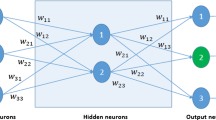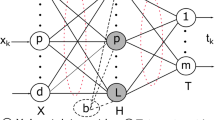Abstract
A learning algorithm based on the modified Simplex method is proposed for training multilayer neural networks. This algorithm is tested for neural modelling of experimental results obtained during cross-flow filtration tests. The Simplex method is compared to standard back-propagation. Simpler to implement, Simplex has allowed us to achieve better results over four different databases with lower calculation times. The Simplex algorithm is therefore of interest compared to the classical learning techniques for simple neural structures.
Similar content being viewed by others
References
Le Cun, Y. Disordered Systems and Biological Organizations. NATO-ASI Series, Springer-Verlag, 1986
Rumelhart D, Zipsner D. Feature discovering by competitive learning. Cognitive Sci 1985; 9: 75–112
Bishop CM. Neural networks and their applications. Revue Scientific Instruments 1994; 65: 1803–1832
Fahlman SE. Faster-learning variations on back-propagation: an empirical study. Proc Connectionist Models Summer School, San Mates, CA, 1988; 38–51
Jacobs RA. Increased rates of convergence through learning rate adaptation. Neural Networks 1988; 1: 295–307
Lippmann RP. An introduction to computing with neural nets. IEEE ASSP Mag 1987; April: 4–22
Solla SA, Levin E, Fleisher M. Accelerated learning in layered neural networks. Complex Syst 1988; 2: 625–640
Sontag ED, Sussmann HJ. Back-propagation can rise to spurious minima even for networks without hidden layers. Complex Syst 1989; 3: 91–106
Baffes PT, Shelton RO, Phillips TA. NETS: a Neural Network Development Tool. Software Technology Branch, Lyndon B. Johnson Space Center, Houston, TX, 1991
Acuna G, Latrille E, Beal C, Corrieu G. Modélisation par réseaux de neurones des cinétiques réactionnelles caractéristiques des fermentations lactiques batch à pH régulé. Récents Progrès en Génie des Procédés 1993; 7: 215–220
Parker DB. Optimal algorithms for adaptive networks: second order back-propagation, second order direct propagation and second order hebbian learning. Proc 1st Int Conf Neural Networks, San Diego, CA, 1987; 593–600
Zurada JM. Introduction to Artificial Neural Systems. West Publishing, 1992
Spendley W, Hext GR, Himsworth FR. Sequential application of Simplex designs in optimisation and evolutionary operation. Technometrics 1962; 4: 441–461
Aberg ER, Gustavsson GT. Design and evaluation of modified Simplex methods. Analytica Chimica Acta 1982; 144: 39–53
Heyd B. Contribution de l'automatique en métrologie et formulation sensorielle. PhD Thesis, Ecole Nationale Supérieure des Industries Alimentaires, Massy, France, 1991
Fredenslund A, Gmehling J, Rasmussen P. Vapor-Liquid Equilibria Using UNIFAC. A Group-Contribution Method. Elsevier Scientific, 1977
Lebert A, Richon D. Infinite dilution activity coefficients of n-alcohols as a function of dextrin concentration in water-dextrin systems. J Agric Food Chem 1984; 32: 1156–1161
Morgan SL, Deming SN. Simplex optimization of analytical chemical methods. Analytical Chem 1974; 46: 1170–1181
Nakai S. Comparison of optimization techniques for application to food product and process development. J Food Sci 1981; 47: 144–176
Subrahmanyam MB. An extension of the Simplex method to constrained nonlinear optimization. J Optimization Theory Applic 1989; 62: 311–319
Nelder JA, Mead R. A Simplex method for function minimization. Computer J 1965; 7: 308–313
Bochereau L. Conception et interprétation des réseaux connexionnistes multicouches. PhD Thesis, Université Paris VII, France, 1991
Brun JP. Procédés de Séparation par Membranes: Transport, Techniques Membranaires, Applications. Masson, 1989
Mulder M. Basic Principles of Membrane Technology. Kluwer Academic, 1991
Dornier M, Rocha T, Trystram G, Bardot I, Decloux M, Lebert A. Application of neural computation for dynamic modelling of food processes: drying and microfiltration. Proc Artif Intell for Agriculture and food. Nîmes, France, 1993, 233–240
Dornier M, Decloux M, Trystram G, Lebert A. Dynamic modeling of crossflow microfiltration using neural networks. J Membrane Sci 1995; 98: 263–273
Dornier M. Développement d'outils pour l'optimisation des conditions hydrodynamiques en filtration tangentielle. PhD Thesis, Ecole Nationale Supérieure des Industries Alimentaires, Massy, France, 1994
Latrille E, Corrieu G, Thibault J. Modélisation par réseaux de neurones: application à des fermentations lactiques batch. Proc Journées d'Etude AFCET-GFGP, Obernai, France, 1992
Rocha Mier T. Influence des prétraitements et des conditions de séchage sur la couleur et l'arôme de la menthe (Mentha spicata Huds.) et du basilic (Ocimum basilicum). PhD Thesis, Ecole Nationale Supérieure des Industries Alimentaires, Massy, France, 1993
Dornier M, Decloux M, Lebert A, Trystram G. Use of experimental design to establish optimal crossflow filtration conditions. J Food Process Eng 1994; 17: 73–92
Punidadas P, Decloux M, Trystram G. Microfiltration tangentielle sur membrane minérale en céramique; application au traitement du sucre roux. Industries Agricoles et Alimentaires 1990; 7–8: 615–623
Decloux M, Dornier M, Gratius I. Crossflow microfiltration of gum arabic solutions: comparison of the classical system with the co-current permeate flow system. Int J Food Sci Tech 1996; 31: 153–166
McClelland JL, Rumelhart DE. Explorations in Parallel Distributed Processing: a Handbook of Models, Programs and Exercises. MIT Press, 1988
Dornier M, Decloux M, Trystram G, Lebert A. Interest of neural networks for the optimization of the crossflow filtration process. Lebensm.-Wiss-Technol 1995; 28: 300–309
Author information
Authors and Affiliations
Corresponding author
Rights and permissions
About this article
Cite this article
Dornier, M., Heyd, B. & Danzart, M. Evaluation of the Simplex method for training simple multilayer neural networks. Neural Comput & Applic 7, 107–114 (1998). https://doi.org/10.1007/BF01414162
Issue Date:
DOI: https://doi.org/10.1007/BF01414162




